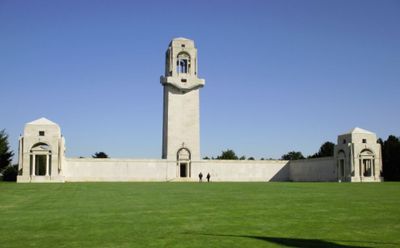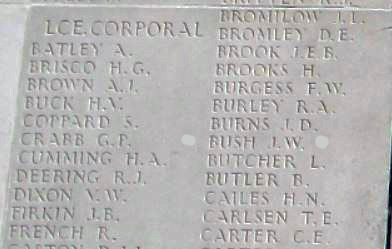Difference between revisions of "James Willie Bush"
From Our Contribution
(→War Service) |
|||
| (7 intermediate revisions by the same user not shown) | |||
| Line 4: | Line 4: | ||
| image2 = | | image2 = | ||
| caption2 = | | caption2 = | ||
| − | | dateofbirth = | + | | dateofbirth = c1883 |
| placeofbirth = Kingsley, Norfolk, England | | placeofbirth = Kingsley, Norfolk, England | ||
| death = 1 Oct 1918 | | death = 1 Oct 1918 | ||
| Line 40: | Line 40: | ||
| fate3 = | | fate3 = | ||
| fate4 = | | fate4 = | ||
| − | | monument1 = Gosnells | + | | monument1 = Gosnells Road Board Honour Roll |
| monumentnote1 = | | monumentnote1 = | ||
| − | | monument2 = | + | | monument2 = |
| − | | monumentnote2 = | + | | monumentnote2 = Should be on Victoria Park Memorial |
| monument3 = Villers-Bretonneux Memorial | | monument3 = Villers-Bretonneux Memorial | ||
| monumentnote3 = | | monumentnote3 = | ||
| Line 62: | Line 62: | ||
==War Service== | ==War Service== | ||
| + | James enlisted on 17 Apr 1916 and completed basic training at Blackboy Hill camp before embarking on the [[HMAT A23 Suffolk]] in Fremantle on 10 Oct 1916 for England. On 2 Dec 1916 he disembarked at Plymouth and was sent to Rollestone to complete his preparation for the Western Front with the [[7th Training Battalion]]. | ||
| − | |||
| − | |||
| − | On 26 Aug 1917 he was again in need of medical attention, seeking the help of the 7th | + | On 28 Dec 1916, with less than a month's preparation he proceeded overseas to France from Folkestone aboard [[HMT Princesse Clementine]]. Following a few days in the 2nd Division's Base Depot in Étaples, James joined the [[28th Battalion]] on 9 Jan 1917 at Mametz where they were in the process of relieving the 19th Battalion in Switch and Needle Trenches near Delville Wood. Two days Later they moved into the front line south east of Guidecourt. On 16 Jan 1917 James was seen by the 36th Casualty Clearing Station and sent on the next day to the [[1st Australian General Hospital]] in Rouen suffering with Pleurites (inflammation of the lung) and Bronchitis. On 21 Jan 1917 he was transferred to England aboard [[HMHS Gloucester Castle]]. |
| + | |||
| + | |||
| + | On arrival he was admitted to the Reading War Hospital where he was treated until 9 Feb 1917 when he was granted leave with orders to report to Perham Downs on 24 Feb 1917. On 27 Feb 1917 he was admitted to the [[2nd Australian Auxiliary Hospital]] before being transferred to [[1st Australian Dermatological Hospital]] at Bulford on 3 Mar 1917 suffering with Venereal Disease. On 12 May 1917 he was released from hospital to duty (total ineffective period being 68 days) and on 14 Jun 1917 he returned to France via Southampton, rejoining his battalion which was in reserve near Bapaume on 2 Jul 1917. Two days before returning to France he was found guilty of Unlawfully altering his Pay Book, for which he was awarded 14 days Field Punishment No. 2. (See notes). Given his movement soon after it is not recorded if he carried out his punishment. | ||
| + | |||
| + | |||
| + | On 26 Aug 1917 he was again in need of medical attention, seeking the help of the [[7th Field Ambulance]] for trench fever. Following treatment, James rejoined the 28th Battalion on 30 Aug 1917. On 1 Oct 1918 the battalion began the day in Templeux Le Fosse, marching to Templeux Le Gerard, closer to the front lines, and then that evening they were urgently called forward to the front through Bellicourt to the le Catelet - Nauroy Line of trenches, arriving there at 3:00am on 2 Oct 1918. A footnote to the days activity in the 28th Battalion's War Diary noted that casualties enroute had been 1 Other Rank killed, and 2 wounded (by shellfire). James was the KIA casualty. While James records indicate that he was buried, he is remembered on the Villers-Bretonneux Memorial so his grave was not able to be found later. | ||
<div><ul> | <div><ul> | ||
| Line 74: | Line 79: | ||
</ul></div> | </ul></div> | ||
| + | ==Post War== | ||
| + | By February 1922 James's wife had moved back to England, living in Bolton Lancashire. | ||
| + | ==Notes== | ||
| + | Field punishment could be awarded by a court martial or a commanding officer for any offence committed on active service. | ||
| + | There were two categories of field punishment. Field punishment No. 2 consisted of heavy labouring duties, and several hours a day shackled . All offenders awarded field punishment would march with their unit, carry their arms and accoutrements, perform all their military duties as well as extra fatigue duties, and be treated as defaulters | ||
| − | |||
| − | |||
| − | |||
<references /> | <references /> | ||
| Line 90: | Line 97: | ||
[[Category:Tramway employee]] | [[Category:Tramway employee]] | ||
[[Category:Methodist]] | [[Category:Methodist]] | ||
| − | |||
[[Category:1918 Deaths]] | [[Category:1918 Deaths]] | ||
[[Category:1918 KIA]] | [[Category:1918 KIA]] | ||
[[Category:Gosnells]] | [[Category:Gosnells]] | ||
| + | [[Category:Victoria Park]] | ||
Latest revision as of 18:20, 18 June 2021
 | |
| Personal Information | |
|---|---|
| Date of Birth | c1883 |
| Place of Birth | Kingsley, Norfolk, England |
| Death | 1 Oct 1918 |
| Place of Death | near Bellicourt, France |
| Age at Enlistment | 32 years, 5 months |
| Description |
5'3¼" (1.61m) tall ; 120lbs 54.431 kg ; fresh complexion ; blue eyes ; brown hair |
| Occupation | Tramway employee |
| Religion | Methodist |
| Address | 307 Albany road, Victoria Park, Western Australia |
| Next of Kin | Wife , Mrs Alice Bush |
| Military Information | |
| Reg Number | 5815 |
| Date of Enlistment | 30 Mar 1916 |
| Rank | Private |
| Unit/Formation | 28th Battalion, 16th Reinforcements |
| Date of Embarkation | 10 Oct 1916 ‒ 2 Dec 1916 |
| Ship Embarked On | HMAT A23 Suffolk |
| Fate | Killed in Action 1 Oct 1918 |
| Monument |
Gosnells Road Board Honour Roll Should be on Victoria Park Memorial Villers-Bretonneux Memorial Australian War Memorial |
| Medals |
British War Medal Victory Medal |
Pre War
James had been an apprentice engineer with the Lancashire and Yorkshire Railway Company, working for them for seven years prior to emigration to Australia. Arrived in Australia two years before he enlisted.
War Service
James enlisted on 17 Apr 1916 and completed basic training at Blackboy Hill camp before embarking on the HMAT A23 Suffolk in Fremantle on 10 Oct 1916 for England. On 2 Dec 1916 he disembarked at Plymouth and was sent to Rollestone to complete his preparation for the Western Front with the 7th Training Battalion.
On 28 Dec 1916, with less than a month's preparation he proceeded overseas to France from Folkestone aboard HMT Princesse Clementine. Following a few days in the 2nd Division's Base Depot in Étaples, James joined the 28th Battalion on 9 Jan 1917 at Mametz where they were in the process of relieving the 19th Battalion in Switch and Needle Trenches near Delville Wood. Two days Later they moved into the front line south east of Guidecourt. On 16 Jan 1917 James was seen by the 36th Casualty Clearing Station and sent on the next day to the 1st Australian General Hospital in Rouen suffering with Pleurites (inflammation of the lung) and Bronchitis. On 21 Jan 1917 he was transferred to England aboard HMHS Gloucester Castle.
On arrival he was admitted to the Reading War Hospital where he was treated until 9 Feb 1917 when he was granted leave with orders to report to Perham Downs on 24 Feb 1917. On 27 Feb 1917 he was admitted to the 2nd Australian Auxiliary Hospital before being transferred to 1st Australian Dermatological Hospital at Bulford on 3 Mar 1917 suffering with Venereal Disease. On 12 May 1917 he was released from hospital to duty (total ineffective period being 68 days) and on 14 Jun 1917 he returned to France via Southampton, rejoining his battalion which was in reserve near Bapaume on 2 Jul 1917. Two days before returning to France he was found guilty of Unlawfully altering his Pay Book, for which he was awarded 14 days Field Punishment No. 2. (See notes). Given his movement soon after it is not recorded if he carried out his punishment.
On 26 Aug 1917 he was again in need of medical attention, seeking the help of the 7th Field Ambulance for trench fever. Following treatment, James rejoined the 28th Battalion on 30 Aug 1917. On 1 Oct 1918 the battalion began the day in Templeux Le Fosse, marching to Templeux Le Gerard, closer to the front lines, and then that evening they were urgently called forward to the front through Bellicourt to the le Catelet - Nauroy Line of trenches, arriving there at 3:00am on 2 Oct 1918. A footnote to the days activity in the 28th Battalion's War Diary noted that casualties enroute had been 1 Other Rank killed, and 2 wounded (by shellfire). James was the KIA casualty. While James records indicate that he was buried, he is remembered on the Villers-Bretonneux Memorial so his grave was not able to be found later.
Post War
By February 1922 James's wife had moved back to England, living in Bolton Lancashire.
Notes
Field punishment could be awarded by a court martial or a commanding officer for any offence committed on active service.
There were two categories of field punishment. Field punishment No. 2 consisted of heavy labouring duties, and several hours a day shackled . All offenders awarded field punishment would march with their unit, carry their arms and accoutrements, perform all their military duties as well as extra fatigue duties, and be treated as defaulters

